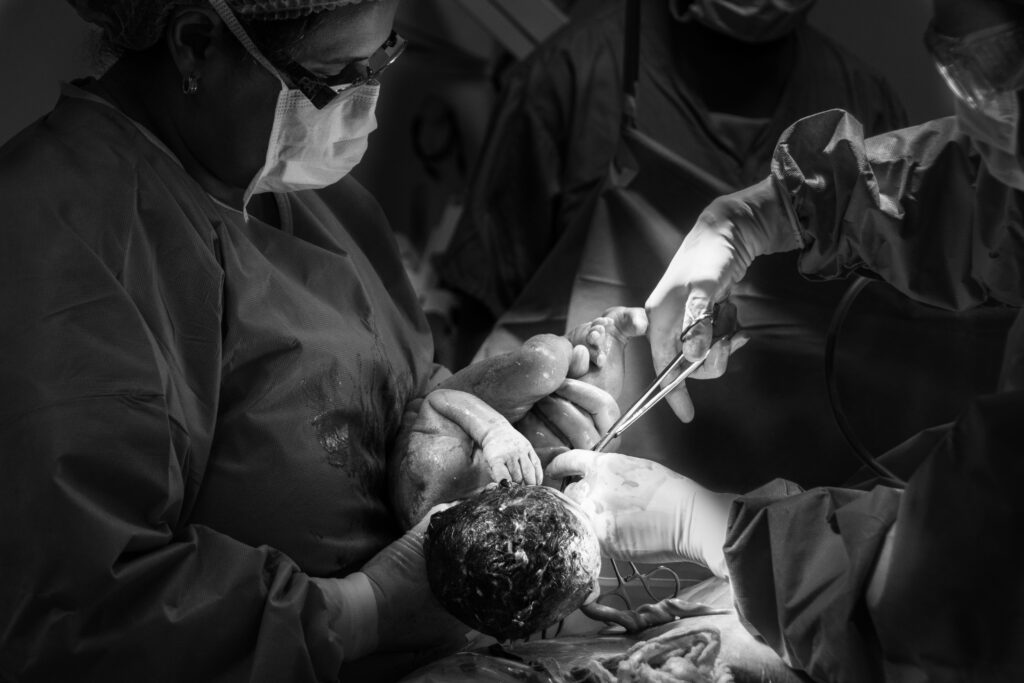Are you expecting and wondering about C-section delivery? Whether you’re planning a cesarean birth or just want to understand your options, this comprehensive guide covers everything you need to know about C-sections from the procedure itself to recovery and beyond. C section is a procedure in which the baby is taken out by making a cut in the lower abdomen. C section is mostly done when vaginal birth is not possible due to some complications.

What is a C-Section? (Cesarean Section Explained)
A cesarean section, commonly called a C-section, is a surgical procedure where your baby is delivered through incisions made in your abdomen and uterus. Unlike vaginal delivery, this method involves surgery and typically requires a longer recovery period.
Quick C-Section Facts:
- About 32% of babies in the US are born via C-section
- The procedure takes 45-60 minutes on average
- Most C-sections use regional anesthesia (you stay awake)
- Recovery typically takes 6-8 weeks
When Do You Need a C-Section?
Planned C-Sections (Elective)
Your doctor might recommend scheduling a C-section if you have:
- Breech baby: Your baby’s bottom or feet are positioned to come out first
- Multiple babies: Twins, triplets, or more in certain positions
- Placenta previa: Your placenta covers the cervix opening
- Previous C-section: Depending on your specific situation
- Large baby (macrosomia): Baby is estimated to be too large for safe vaginal delivery
- Maternal health conditions: Such as severe preeclampsia or heart disease
Emergency C-Sections
Sometimes a C-section becomes necessary during labor due to:
- Fetal distress: Your baby’s heart rate shows signs of trouble
- Stalled labor: Labor isn’t progressing despite strong contractions
- Umbilical cord problems: The cord drops down before your baby
- Placental abruption: The placenta separates from your uterus too early
The C-Section Procedure: What to Expect Step-by-Step
Before Surgery (Preparation)
- Anesthesia: You’ll receive spinal or epidural anesthesia to numb your lower body
- Catheter insertion: A tube is placed to drain your bladder during surgery
- IV placement: For fluids and medications
- Surgical site prep: Your abdomen is cleaned and draped
During the C-Section
- Incision: Your surgeon makes a horizontal cut (usually) just above your pubic hairline
- Baby delivery: Your baby is carefully lifted out (this happens quickly!)
- Placenta removal: The placenta is delivered
- Closing up: Each layer is carefully sutured closed
Timeline: The entire procedure takes 45-60 minutes, but your baby is usually born within the first 10-15 minutes!
What You’ll Feel
- Pressure and tugging sensations (no pain due to anesthesia)
- Possible nausea from medications
- Excitement when you hear your baby’s first cry!
C-Section Recovery: Your Healing Journey
Hospital Stay (2-4 Days)
Your recovery team will help you with:
- Pain management with safe medications
- Getting up and moving (sooner than you might think!)
- Breastfeeding support if desired
- Incision care instructions
First Few Weeks at Home
Do:
- Rest as much as possible
- Accept help with household tasks
- Take pain medication as prescribed
- Keep your incision clean and dry
- Walk short distances to prevent blood clots
Don’t:
- Lift anything heavier than your baby
- Drive until you can brake comfortably (usually 2-3 weeks)
- Take baths (showers are fine)
- Do strenuous exercise
Full Recovery Timeline
- Week 1-2: Focus on rest and bonding with baby
- Week 3-4: Gradually increase activity
- Week 6-8: Most restrictions lifted after doctor’s clearance
- 3-6 months: Complete internal healing
C-Section vs. Vaginal Delivery: Understanding the Differences
| Aspect | C-Section | Vaginal Delivery |
|---|---|---|
| Hospital Stay | 2-4 days | 1-2 days |
| Recovery Time | 6-8 weeks | 2-6 weeks |
| Pain Management | Prescription medications | Usually milder pain relief |
| Breastfeeding | May take longer to establish | Often easier to start |
| Future Pregnancies | May affect delivery options | Generally no restrictions |
C-Section Risks and Benefits: Making Informed Decisions
Benefits of C-Section Delivery
- Life saving in emergency situations
- Controlled timing for high risk pregnancies
- May prevent birth injuries in certain cases
- Can be scheduled for convenience (planned C-sections)
Potential Risks to Consider
Short-term risks:
- Bleeding and infection
- Blood clots
- Adverse reactions to anesthesia
- Injury to nearby organs (rare)
Long-term considerations:
- Scar tissue formation
- Increased risks in future pregnancies
- Longer recovery compared to vaginal birth
VBAC: Can You Have a Vaginal Birth After C-Section?
Many women can safely have a Vaginal Birth After Cesarean (VBAC)! Success depends on factors like:
- Reason for previous C-section
- Type of uterine incision
- Time between pregnancies
- Your overall health
VBAC success rates are approximately 60-80% for appropriate candidates. Discuss this option with your healthcare provider early in pregnancy.
Preparing for Your C-Section: Tips for Success
Before Surgery
- Ask questions: Understand why the C-section is recommended
- Arrange help: Line up support for your first few weeks home
- Prepare your home: Stock up on essentials, prepare easy meals
- Pack your hospital bag: Include comfortable, loose-fitting clothes
Mental Preparation
- It’s normal to feel anxious about surgery
- Consider taking a C-section preparation class
- Connect with other moms who’ve had positive C-section experiences
- Remember: C-sections are very common and generally safe
C-Section Myths vs. Facts
Myth: “C-sections are the easy way out” Fact: C-sections involve major surgery and longer recovery – they’re not easier!
Myth: “You can’t breastfeed after a C-section” Fact: You absolutely can breastfeed! It might take a bit longer to establish, but it’s definitely possible.
Myth: “Once you have a C-section, you always need one” Fact: Many women successfully have vaginal births after C-sections (VBAC).
When to Call Your Doctor After C-Section
Contact your healthcare provider if you experience:
- Heavy bleeding (soaking more than one pad per hour)
- Signs of infection (fever, chills, foul-smelling discharge)
- Severe abdominal pain
- Redness, swelling, or warmth around your incision
- Difficulty breathing or chest pain
- Leg pain or swelling (could indicate blood clots)
Your C-Section Birth Story Matters
Remember, however your baby arrives – whether through planned C-section, emergency surgery, or vaginal delivery – what matters most is that you and your baby are healthy and safe. Your birth experience is valid and beautiful, regardless of the method.
Frequently Asked Questions About C-Sections
Q: How long does C-section surgery take? A: The entire procedure typically takes 45-60 minutes, with your baby being born within the first 10-15 minutes.
Q: Will I be awake during my C-section? A: Most C-sections use spinal or epidural anesthesia, so you’ll be awake but won’t feel pain. General anesthesia is only used in emergencies.
Q: How many C-sections can you safely have? A: While there’s no set limit, most doctors recommend no more than 3-4 C-sections due to increasing risks with each surgery.
Q: Can my partner be in the operating room? A: Yes! Your partner can usually stay with you during the surgery and be there when your baby is born.
Q: When can I drive after a C-section? A: Most doctors clear patients to drive 2-3 weeks post-surgery, once you can comfortably brake and turn without pain.
Final Thoughts on C-Section Delivery
C-sections are a safe, common way to welcome your baby into the world. Whether yours is planned or unexpected, focus on your recovery, bonding with your little one, and celebrating this incredible milestone. Trust your medical team, ask questions, and remember that you’re stronger than you know.
Ready to learn more about pregnancy and birth? Check out our other helpful articles on All about C- Section. Have questions about C-sections? Drop them in the comments below!
Medical Disclaimer: This article is for informational purposes only and should not replace professional medical advice. Always consult with your healthcare provider about your specific situation and medical needs.

Leave a Reply